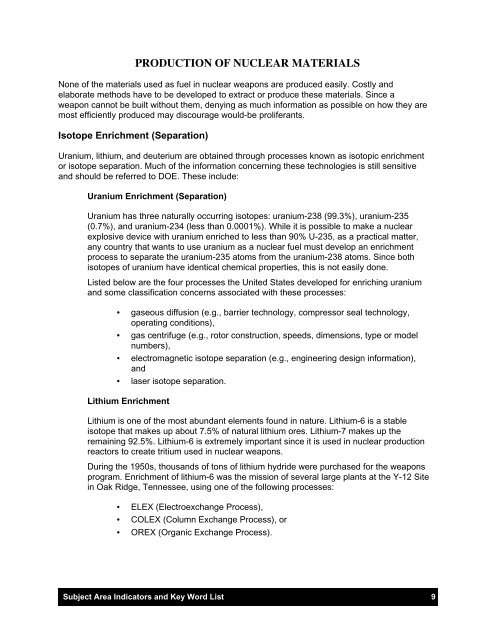U.S. Department of Energy - OSTI
U.S. Department of Energy - OSTI
U.S. Department of Energy - OSTI
You also want an ePaper? Increase the reach of your titles
YUMPU automatically turns print PDFs into web optimized ePapers that Google loves.
PRODUCTION OF NUCLEAR MATERIALS<br />
None <strong>of</strong> the materials used as fuel in nuclear weapons are produced easily. Costly and<br />
elaborate methods have to be developed to extract or produce these materials. Since a<br />
weapon cannot be built without them, denying as much information as possible on how they are<br />
most efficiently produced may discourage would-be proliferants.<br />
Isotope Enrichment (Separation)<br />
Uranium, lithium, and deuterium are obtained through processes known as isotopic enrichment<br />
or isotope separation. Much <strong>of</strong> the information concerning these technologies is still sensitive<br />
and should be referred to DOE. These include:<br />
Uranium Enrichment (Separation)<br />
Uranium has three naturally occurring isotopes: uranium-238 (99.3%), uranium-235<br />
(0.7%), and uranium-234 (less than 0.0001%). While it is possible to make a nuclear<br />
explosive device with uranium enriched to less than 90% U-235, as a practical matter,<br />
any country that wants to use uranium as a nuclear fuel must develop an enrichment<br />
process to separate the uranium-235 atoms from the uranium-238 atoms. Since both<br />
isotopes <strong>of</strong> uranium have identical chemical properties, this is not easily done.<br />
Listed below are the four processes the United States developed for enriching uranium<br />
and some classification concerns associated with these processes:<br />
• gaseous diffusion (e.g., barrier technology, compressor seal technology,<br />
operating conditions),<br />
• gas centrifuge (e.g., rotor construction, speeds, dimensions, type or model<br />
numbers),<br />
• electromagnetic isotope separation (e.g., engineering design information),<br />
and<br />
• laser isotope separation.<br />
Lithium Enrichment<br />
Lithium is one <strong>of</strong> the most abundant elements found in nature. Lithium-6 is a stable<br />
isotope that makes up about 7.5% <strong>of</strong> natural lithium ores. Lithium-7 makes up the<br />
remaining 92.5%. Lithium-6 is extremely important since it is used in nuclear production<br />
reactors to create tritium used in nuclear weapons.<br />
During the 1950s, thousands <strong>of</strong> tons <strong>of</strong> lithium hydride were purchased for the weapons<br />
program. Enrichment <strong>of</strong> lithium-6 was the mission <strong>of</strong> several large plants at the Y-12 Site<br />
in Oak Ridge, Tennessee, using one <strong>of</strong> the following processes:<br />
• ELEX (Electroexchange Process),<br />
• COLEX (Column Exchange Process), or<br />
• OREX (Organic Exchange Process).<br />
Subject Area Indicators and Key Word List 9
















